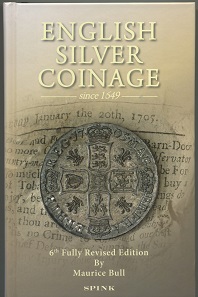by Björn Schöpe
translated by Annika Backe
May 5, 2016 – Most catalogs cannot be updated as quickly as is desirable. All the greater the joy when an important catalog actually has been thoroughly revised – as is the case with Spink’s “English silver coinage”.
Maurice Bull, English Silver Coinage since 1649. London, Spink, 2015. 6th revised edition. 676 pages with b/w illustrations. Hardcover. 14.7 x 22.3 cm. ISBN: 978-1-907427-50-3. GBP 40.
In 1949, H.A. Seaby presented the first catalog on the English silver coinages between 1649 and 1949. Afterwards, P.A. Rayner updated the monograph once every decade or so (1957, 1968, 1974, and 1992). The long break preceding the last edition from 1992 is indicative of the efforts it took to complete the work. The numismatic community had to wait for a new edition for more than 20 years. Maurice Bull has now presented an entirely new book.
Bull did not take the easy way out but – as he states in the preface – checked with many experts. On the one hand, he could take all the data from the 5th edition. On the other hand, though, he had to arrange that data in an entirely new way. The catalog used to be divided according to denominations; besides, the catalog numbers had become confusing due to supplemented letters added in the course of some substantial reworking (for example, 1847A-E).
Bull freed the catalog from the dust systematically, arrived at a new arrangement, updated and augmented it with a wealth of information. For starters, the catalog is now arranged according to rulers and subdivided according to denominations which are then arranged according to types and, lastly, to dates. To facilitate utilization, the old catalog number is still stated. Apparently from his own painful experiences and to make things easier for a future author, Bull has left a few numbers blank between the rulers, for future additions.
Although the book is nearly three times as weighty as the former edition, it lists fewer types. The reason is simple: Maurice Bull believed that sometimes a “type” only harks back to the imperfections of manual minting. At this point, the expert might discuss points of detail. Yet every catalog bears the signature of its author, and such a trimming is legitimate. How meticulously Bull has worked is reflected in the comprehensive appendix. Not only does it list patterns for the first time, but it provides detailed references as to where every mentioned catalog number can be found. Finally, therefore, those objects whose existence used to be a matter of dispute are scientifically testified. Another new feature was prompted by the collector’s request to also state mintages. As far as possible, Bull gives the individual mintage of the Royal Mint for every year. Needless to add, that the book is concluded by a bibliography.
The catalog is a glowing example for what an author achieves if he strives for bringing a standard reference up-do-date and making it suitable for the needs of different target audiences. Collectors, connoisseurs, non-experts, researchers – they will all be enabled to access the reasonably arranged material easily and find references for individual pieces quickly. In short, this is a laudable work which deserves many future readers and just as many new editions that are likewise done with care.
By the way, Maurice Bull currently works on the catalog on the English gold coinage since 1649, and appreciates any information on hitherto unpublished material with accompanying illustrations. If you want to contact him, please write an email to Maurice Bull.
His book on the silver coinage you can find on the Spink website.




